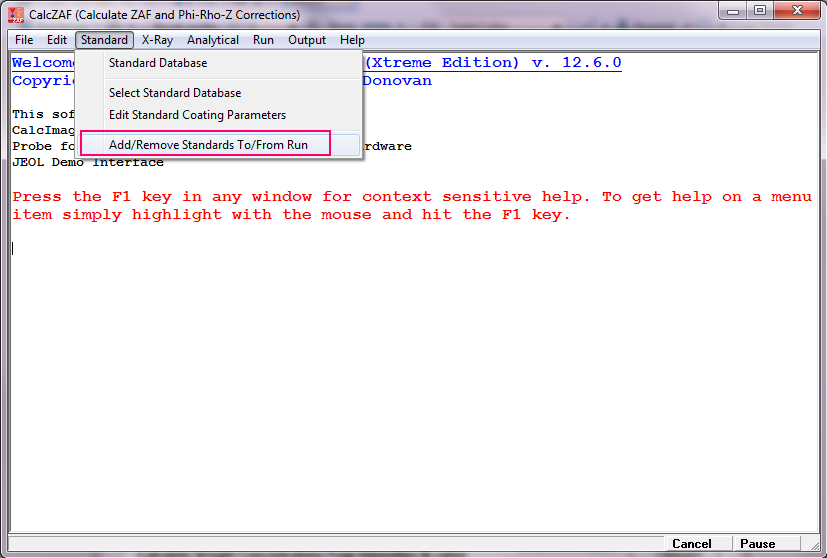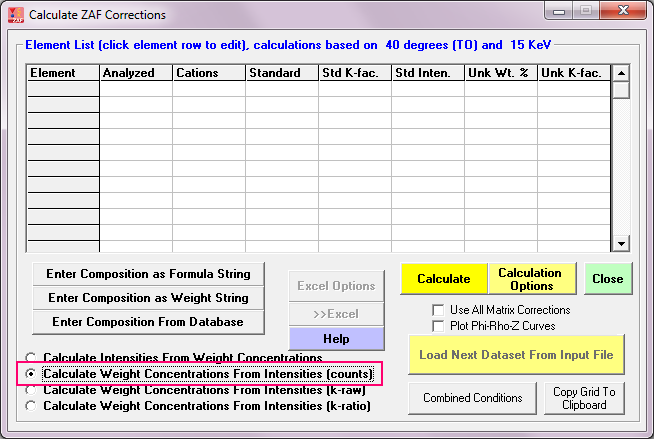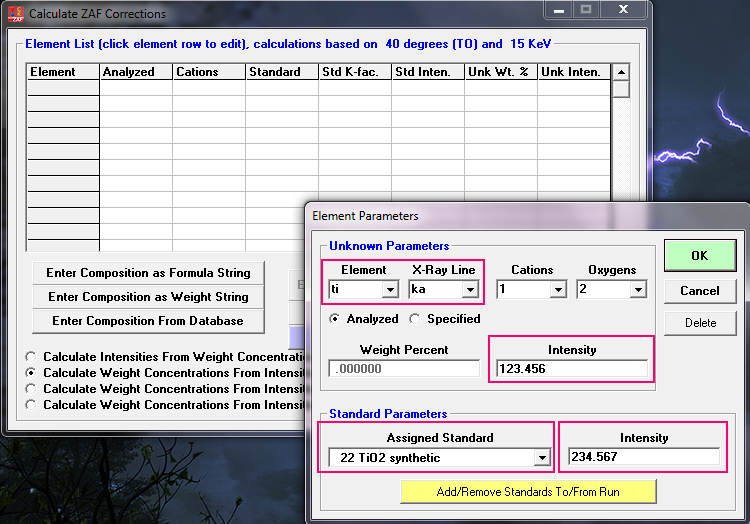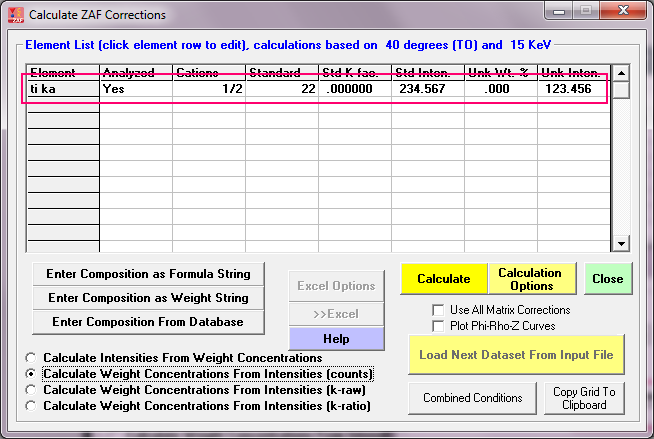I've being playing around and trying to figure this program out for a while now and following the examples doesn't really help me.
Hi Nik,
Sorry about that. I'll try to help you with the data entry in CalcZAF for calculating concentrations from intensities.
But let me just mention that measuring compounds like this is what we microprobers do everyday. That said, this particular composition is problematic for several reasons. Among these issues are the self interference of Ti Ka and Ba La with each other (even with WDS it's there, but generally pretty small). And the interference of Ti L lines on O Ka, and also the peak shape issues with O Ka (from different chemical states in the unknown and standard), not to mention uncertainties in the MAC (mass absorption coefficient) values for O by Ti and Ba.
All of these can be dealt with properly, but it's not trivial or simple to do right.
Then acquired the same energy scans on our BaTiO3 sample, in hope to determine the Ba to Ti ratio.
I want to Calculate Weight Concentrations From Intensities (k-raw) (as I've got a measured standard).
First, when I try to add a New standard and where do I specify the measures standard intensities? Are they collected from the EDS Spectrum? Because I just can't get it to read correctly any spectrum at all.
I will provide a brief description of the basic steps in using CalcZAF to calculate concentrations from intensities, but since you did not specify what standards you utilized for your attempt in quantifying the BaTiO3 sample, I will have to make some assumptions.
First of all, what Ben Buse wrote above is the first problem you need to deal with. CalcZAF is not designed to process EDS (or WDS) spectra, so to begin with you need to calculate net intensities for both the Ba La and O ka emission lines in your unknown, and *also* for your Ba and O standards. You didn't mention Ti, but since your unknown sample also contains Ti, you'll also want to obtain a net intensity for your Ti standard on the Ti Ka emission line (and also for the unknown).
Now these net intensities could be obtained in different ways as Ben mentioned. They could be peak intensities, that have been background corrected by measuring the background intensities on each side of the peak and then interpolating the value under the peak. Which is normally what is done in WDS quantification.
But one could also perform wavescans and obtain the integrated area under each peak, but again correcting for background. The advantage of using WDS scans like you did, is that you can calculate an integrated intensity for the peaks, which for oxygen is good because that method automatically deals with any peak shape issues from different chemical states. Ba La and Ti Ka are not affected by chemical states, so those could be simple peak minus interpolated background net intensities (I told you this composition would not be easy!).
The important point is that one must measure their unknown and their standards the same way. So when the k-ratio is constructed for each element, both the unknown and the standard intensities are both peak - background or both integrated - background.
Once you have net intensities for your Ba, Ti and O emission lines in both your unknown and the standards for Ba, Ti and O, the first step in CalcZAF is to specify the standards using the Add/Remove Standard To/From Run menu as seen here:

These standards could be nominal compositions already in the default standard database, or you can add your own standard compositions using the Standard.exe application.
I selected TiO2 for the Ti standard, and also for the O standard. But this might not be a good idea since there can be an interference of Ti L on O Ka, but it depends on your WDS spectral resolution. You might instead want to utilize a Ti metal standard for Ti and say an MgO standard for your oxygen standard. You will need to figure out what standards you have and can measure.
In the Calculate ZAF Corrections window, when I add an element, in Element Parameters, what do I put as the intensity? Is that the highest value peak intensity, the intregrated peak intensity (background corrected), the FWHM of the peak (background corrected)?
The next step is to add the standard and unknown intensities to CalcZAF. This is done by first selecting the intensity type you will be entering. You said you wanted to utilize "concentrations from intensities" so that is this option:

You now click on an empty line and enter the emission line, the unknown net intensity, the standard, and finally the standard net intensity:

I just entered some random numbers for the intensities, but you'll want to enter your net intensities from your actual measurements on your unknown and your standards. Of course these net intensities should be intensities normalized to cps/nA. When you click OK, you will see this for the first element:

Then again click a blank line for your Ba and O emission lines and enter the corresponding parameters for those elements. When you are done, simply click the Calculate button and you should get a concentration from intensities output.
Please let us know if you have further questions.